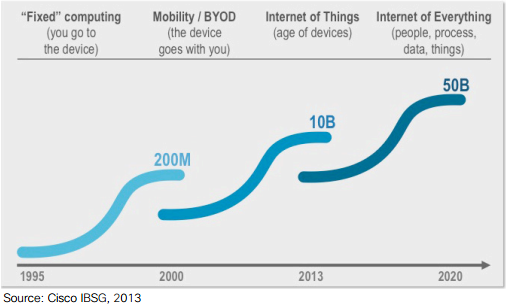The Internet of Everything = 50 Billion Connected Devices + Bluetooth Smart

At the recent Consumer Electronics Show, John Chambers, President and CEO of Cisco Systems gave a forward-looking keynote speech stating that the “Internet of Everything” (IoE) market would create $19 trillion (yes, that’s with a “t”) in economic benefit over the next decade. What was as significant as the size was that, according to Mr. Chambers, 2014 is the tipping point year that gets it all started.
As an illustration of the growth of connected devices, Chambers noted that there were only 1,000 devices connected to the Internet when Cisco was created in 1984. That number passed the world’s population in 2010 when there were more than 10 billion connected devices, and by 2020, Chambers expects to see 50 billion devices connected to the Internet.
Huge Market Opportunity + Bluetooth Smart
By definition, the Internet of Everything market includes three different types of connections – machine-to-machine (M2M), person-to-machine (P2M), and person-to-person (P2P). Advances in hardware and software technology are moving us rapidly from the Internet of Things towards the larger Internet of Everything. While faster, low power processors and high speed data connections are key factors in the move, a less known but equally significant mobile technology – Bluetooth Smart – will act as a major catalyst further accelerating the growth of the emerging P2M and P2P segments of the huge ‘IoE’ market.

Apple recently announced specifications for its new iBeacon wireless, ‘micro-location’ technology. The initial buzz was all about how physical businesses will be using these iBeacons for context aware ecommerce and how stores will be equipped with them to guide shoppers. While this may be true, the bigger story is the fact that the iBeacon hardware and software protocols are built around a Bluetooth Low Energy technology called ‘BLE’ now branded as ‘Bluetooth Smart’. BLE is a very low power protocol for use with Bluetooth radios that allows battery powered devices to communicate using very little power and makes smartphones ideal for communicating with all kinds of “always connected” devices.
New Standard Creates Inflection Point
Apple has added full support for BLE in all iPhones since the 4S and with all new Android phones also supporting the BLE standard, there are already over a half a billion BLE/Bluetooth Smart capable devices in use around the world. This huge installed base has probably already put the final nail in the coffin of Near Field Communication (NFC), the once heralded digital wallet enabler that had started gaining traction in Europe. BLE and iBeacons should easily dominate the ecommerce market as it is much more robust (30 feet transmission distance versus 8 inches) and cost effective than NFC. Look for Apple and others to make big moves into mobile commerce using BLE as the ‘last mile’ connection technology.
Home automation is the next market to change radically due to BLE. BLE allows home automation systems to be much cheaper and easier for the consumer to install and maintain. No more confusing wall panels, custom controllers and universal remotes necessary, smartphones will control devices directly using BLE as the connection.
In the industrial and business markets, BLE will radically change how data gets collected and eventually funneled back to the internet where it can be processed, displayed and analyzed. In industrial equipment, BLE will help to enhance or completely eliminate the need for data displays and control panels. Want to get readings from a machine, meter or other embedded device? Simply power up the associated application on your mobile phone and utilize the high resolution, full color, touch screen display of your phone versus a limited, B/W display with bewildering, multiplexed buttons.
The Internet of Everything will accelerate rapidly driven by advances in mobile connectivity such as BLE/Bluetooth Smart. Businesses in all industries can take advantage of this inflection point by looking hard at how these new technologies will combine to change the way their stand-alone ‘siloed’ products and systems interact with the world.
Now is the time to seriously follow SemperCon’s – ‘always connected’ doctrine by moving to allow valuable data to be pulled from all devices/sources, connected to the internet, and made available for use in analytics and determining appropriate action. Please let us know if we can help you review your mobile strategy to take full advantage of these market forces.
